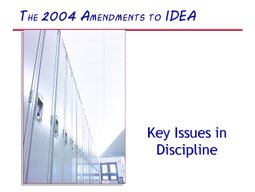 by Renee Bradley
by Renee Bradley
Office of Special Education Programs
U.S. Department of Education
October 2007 (see Editor’s note, below)
- English only slideshow
- Handouts for Participants in English and in Spanish
Editor’s note | January 2018 | While the date of publication for this training module was October 2007, the information provided about IDEA’s discipline rules is still accurate. The discipline regulations covered in the law have not changed since this module was written. What’s most likely out of date as of January 2018 will be the many references to resources of further information or assistance on the subject of discipline of children with disabilities. For a list of the most current resources on this very important subject, we invite you to visit CPIR’s Resource Collection on Positive Behavior Supports, Functional Behavioral Assessment, and School Discipline, at:
https://www.parentcenterhub.org/pbs-fba-bip-discipline-resource-collection/
___________________
 Module 19 discusses IDEA’s very specific procedures for disciplining students with disabilities who violate a code of student conduct. These have changed significantly from prior law, where they were first introduced. Can a school suspend or expel a student with a disability for violating a code of student conduct? Change his or her placement? Is a manifestation determination necessary? What rules apply? This module will tell you. It concludes with case study examples.
Module 19 discusses IDEA’s very specific procedures for disciplining students with disabilities who violate a code of student conduct. These have changed significantly from prior law, where they were first introduced. Can a school suspend or expel a student with a disability for violating a code of student conduct? Change his or her placement? Is a manifestation determination necessary? What rules apply? This module will tell you. It concludes with case study examples.
Module 19 is available in English only (except for the handouts for participants, which are also available in Spanish). The module includes:
- a slideshow presentation;
- a Trainer’s Guide; and
- handouts for participants in both English and Spanish.
Please help yourself below, and download the components you need to learn on your own and/or to train others regarding IDEA’s disciplinary procedures.
Just looking for a quick summary?
That will be hard to come by, we regret to say. IDEA’s discipline rules are too complicated to summarize quickly. However, we can offer you a not-so-brief summary that is still markedly shorter than this training module! Visit:
______________________________
Component #1: Slideshow
English only
There are 22 full-color slides to use in training audiences on IDEA 2004’s disciplinary procedures.
- Slideshow for Module 19 (in a ZIP folder)
- Tips for Downloading and Using Slideshow
Component #2: Trainer’s Guide
The Trainer’s Guide illustrates how each slide operates and provides detailed discussion of the content on each slide. It’s available in both a nicely laid out PDF file with thumbnail graphics of the slides and as an accessible Word file (from which you can freely copy and paste content to other documents). Which would you like?
- PDF | Complete Guide
- Word | Complete Guide (Accessible Word file)
Component #3: Handouts for Participants | Folletos para Participantes **
In English and in Spanish
The handouts for Module 19 are included in a packet of handouts designed to cover the entire umbrella topic of Theme E, Procedural Safeguards under IDEA 2004. If you’ve downloaded the handouts for Theme E already (for example, as part of training on Modules 17 or 18), you have the handouts you need for Module 19. If you haven’t downloaded any handouts for Theme E yet, here they are in 2 different formats and 2 different languages.
English Handouts, Theme E
Word | Handouts for Theme E (Accessible Word file)
Spanish Handouts, Theme E
Word | Folletos para Tema E (Accessible Word version)
Note about the Spanish Translations:
In preparing the handouts in Spanish, we chose to use a certain vocabulary set for the terminology most frequently used in IDEA. IDEA itself is extremely and purposefully consistent about its terminology, and we felt it critical to do the same in Spanish. However, we fully recognize that there are many ways to say the same thing, and Spanish is rich with alternatives from country to country, region to region. So we’ve also prepared a glossary of the terminology used in IDEA, how we’ve rendered that terminology in Spanish, and other ways of rendering it that families may also hear. Share this with participants as you see fit or use it to guide your own translations. The glossary of terminology is available in two formats, PDF and Word:
There! Module 19 is all yours!
Please remember that these materials are designed to be a thorough and authoritative source of info on IDEA 2004’s disciplinary procedures. That’s why they are so detailed. As a trainer, you are free to adapt the info we’ve offered to serve the purposes and needs of your audiences and the amount of time you have to spend with them.
Back to top
________________________________________________________
**Highly Rated Resource! This resource was reviewed by 3-member panels of Parent Center staff working independently from one another to rate the quality, relevance, and usefulness of CPIR resources. This resource was found to be of “High Quality, High Relevance, High Usefulness” to Parent Centers.
________________________________________
Quick-Jump Menu to Other Modules
1: Top 10 Basics of Special Education
2: Key Changes in IDEA
5: Disproportionality and Overrepresentation
6: Early Intervening Services and Response to Intervention
7: Highly Qualified Teachers (withdrawn with the reauthorization of NCLB as the ESSA in 2015)
8: NIMAS
9: Introduction to Evaluation under IDEA
10: Initial Evaluation and Reevaluation
11: Identification of Children with Specific Learning Disabilities
12: The IEP Team
13: Content of the IEP
14: Meetings of the IEP Team
15: LRE Decision Making
16: Children Enrolled by Their Parents in Private Schools
17: Introduction to Procedural Safeguards
18: Options for Dispute Resolution
19: Key Issues in Discipline (you’re already here)

